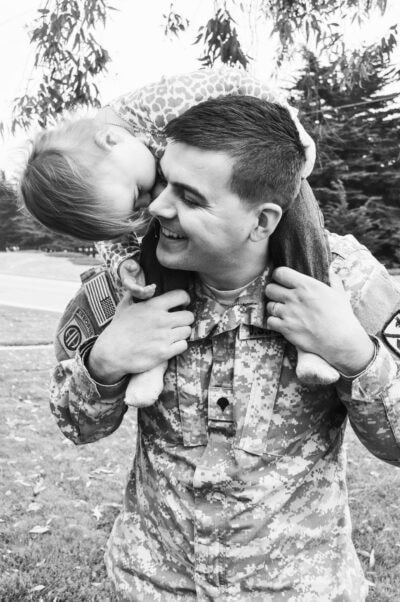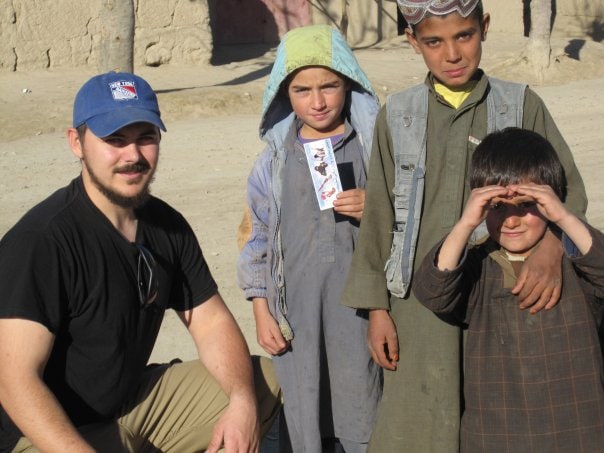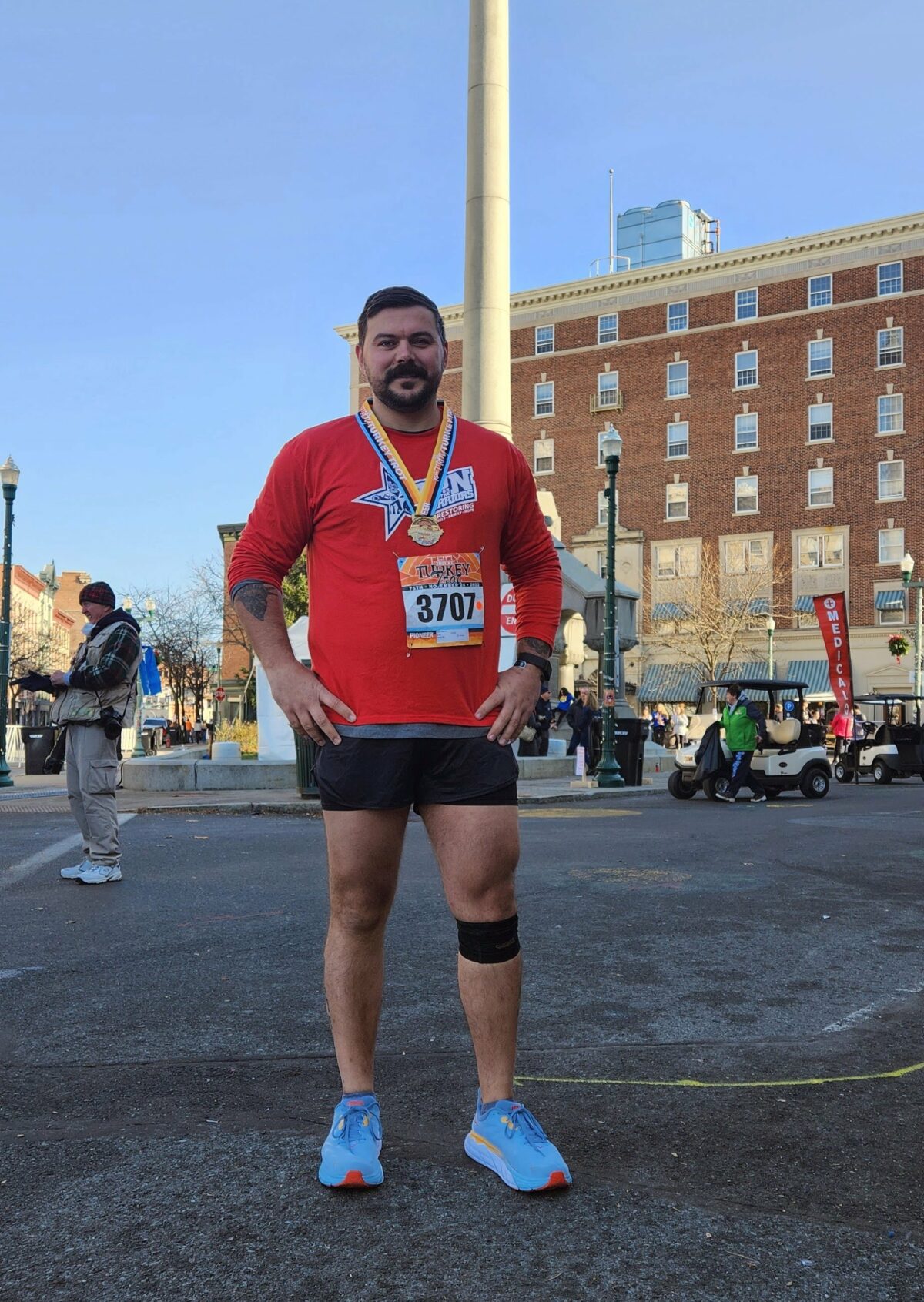STRENGTH IN EVERY STORY™
A Proactive Approach to Managing Migraine: Q&A with Stephen
Stephen’s Story, January 2025
As told to: Diego Colón
Diagnosis received: Migraine
Symptoms: Pain at the top front of the head, Aching pain around the head, Body aches, Sensitivity to light
In 2008, driven and courageous 21-year-old Stephen, was in the United States Army Airborne School when he sustained a neck injury. With no other apparent complications, Stephen quickly regained his strength within a few days, but was unaware that the condition would develop into something more over the years.
Along the way, additional injuries worsened his neck injury, and he later discovered he underwent an annular tear*. Four years later, Stephen sought relief and received treatment for the tear. Shortly after treatment, Stephen dropped to the ground with debilitating pain. He experienced his very first migraine attack.
Here, he discusses the importance of being proactive when seeking care through the (U.S. Department of Veterans Affairs) VA healthcare system, the value of holistic approaches beyond that of medications, and the crucial issue many veterans face today: the underdiagnosis of post-injury symptoms, and the need for better advocacy and treatment options.

Q: Can you tell us about your military background?
I was medically retired as a Sergeant E-5 [of the U.S. Army], and right now I am the Director of Military and Veteran Success at Hudson Valley Community College.
Q: What’s your headache disorder and/or migraine disease diagnosis, and where is the pain most prominent?
[It’s] migraines. [I] rated 30% through the VA for it. Most of it [the pain] is up on the top front part of my head. As they grow [or intensify], I’ll say, it starts wrapping around my head, and then I’ve had a few times where the migraine turns into body aches, where my whole body hurts. It’s not too often that it gets that bad, but sometimes it does. I’ve had to go to the emergency room four times now because my typical medications, home remedies, and stuff just weren’t enough. There was even a case once where they had to give me morphine** because it was so bad.
Q: Are your migraine attacks service-related?
Yep. I’d never even had a headache, migraine, nothing my entire life. In the service, it was my last jump in airborne school. [It] was a little rougher than the others, and it resulted in a neck injury that developed over a few years.
So, at first it wasn’t really that big [of] a deal, [I was] 21 years old; the body just kind of bounced back within a few days. Over the years, [through] more wear and tear, it increased or exacerbated the injury to my neck, which after they did some more scans, they found I had an annular tear.
If you’re not familiar with what that is, you have your spinal cord. There’s this jelly-like stuff around your spinal cord; … I literally had a tear in my neck where that jelly-like stuff was coming out and it was frying all my nerves… So, I have nerve damage through[out] my whole upper body. One of the treatments was to do a neck injection for pain. I forget what the medication was called, but they essentially, under [an] X-ray, they did a numbing thing, [while I was] awake, and they just put a needle [injection] right into the back of your neck, and it’s supposed to help with the pain.
Almost immediately after, I had this blinding migraine. This was the first one I ever had. I dropped to the ground because it was so debilitating. It was because of that injection…it did something there to start this whole migraine thing. From there, it was little migraines and then all of a sudden, I would have a really bad one…
Q: What does your migraine treatment/care consist of and is it effective?
I lived with it [migraine] long enough where I can tell when they’re [the attacks] going to happen [or] before they happen. I can be really proactive. I do the hot foot bath… I’ll do that and keep things cold and dark and try to ride it out. [With] medications, I don’t know what it is with me, but medications don’t really work that well unless they’re very potent… Controlling my environment, my situation, that’s been helpful. Even in my office here, they put LED lighting, so it’s a little bit better [to manage].
Q: What advice do you wish you could’ve given yourself to navigate the journey toward effective treatment/care more quickly?
I would’ve told myself… [start] looking into more proactive, holistic ways to treat the migraines and not just rely on the medications that the doctors give me, because that’s more reactive. There are things that I know now that I can do just to keep it [migraine attacks] calm…taking too much of a medication, especially when I don’t have the migraine, might not be beneficial to my body. So, doing these holistic things, regularly keeping things a little darker [and] a little cooler… on a regular basis can help mitigate how often they happen and the severity.
Q: What is your experience navigating the VA system? What steps did you take to make the more challenging aspects of the process easier?
My VA primary doctor, he’s great. Even [when dealing with] stuff other than migraines, whenever I’m like, ‘Hey, I’m dealing with this. What can we do?’ He was responsive [and] helpful. The issue I have, and [what] other veterans need to do when working with the VA is you have to be very proactive… You’d think that they would be in a little more exchange [with you], but they’re not. If you’re not contacting them, they’re not going to reach out to you unless you have an appointment coming up.
If you want something dealt with, you’ve got to make sure that conversation [with your doctor] is going and continuing, letting them know how things are working. You can do that with the VA app, [which] has secured messaging on there; it’s the easiest way [to communicate].
I use it all the time. I’ll be like, ‘Hey doc, this med isn’t working, or this treatment is helping,’ and they’ll respond. I’ve always had good responses, but they’re never really proactive in helping you overcome your situation.
Q: Was there something in your migraine care journey that you didn’t realize you needed until you found it—something that made you wonder how you managed without it?
This is actually something I am looking [into] again because I want to be doing it more often—cryotherapy. I was blown away by how effective that worked and helped. It’s immediate. You go into the cryo-chamber thing for like a minute to 3 minutes at most, I have [endured a] neck, back, hip, and knee injury…but everything felt good immediately after that cryotherapy session. I could think clear, I could move, I had energy… I went home and cleaned my whole house because I had the energy to do it. It was crazy.
Q: What is something you would want to ask from Congress about advocacy for migraine disease?
Veterans are highly underdiagnosed for brain injury. Similar to what other athletes are going through, a CTE. It’s not a full-on concussion, but it’s a hard enough knock. Your brain just brushes up against [the] inside of your skull. The inside of your skull is pretty rigid and rough, and your brain tissue is so soft [and] fragile…
Blackouts from all of the IEDs, RPGs, all the stuff that was hit in our vehicles, explosions that were going nearby, I guarantee you I had [developed] plenty of CTE. You look at the symptoms of CTE, and you’re going to see exactly what the veteran population is dealing with right now. Everything from depression, anxiety, cognitive dysfunction, [and] suicide. All of these things are symptoms of brain injury. We just need to be more proactive and actually get diagnoses out there and treatment at all these VA hospitals. There’s so much information on how to treat them effectively…


* An annular tear occurs when the outer layer (annulus fibrosus) of a spinal disc tears, potentially allowing the inner jelly-like material (nucleus pulposus) to leak out, leading to pain and inflammation.
**Disclaimer: Morphine is mentioned here. The use of opioids is not recommended for the treatment of headache disorders or migraine disease. Evidence suggests they may be ineffective and carry significant risks of medication overuse headache and dependance. (American Headache Society, 2019)
If you are experiencing headache or migraine attacks, track and record your symptoms, and set a dedicated appointment with your healthcare provider to learn more about your diagnosis and treatment options, and possible referral to a specialist, as needed.
